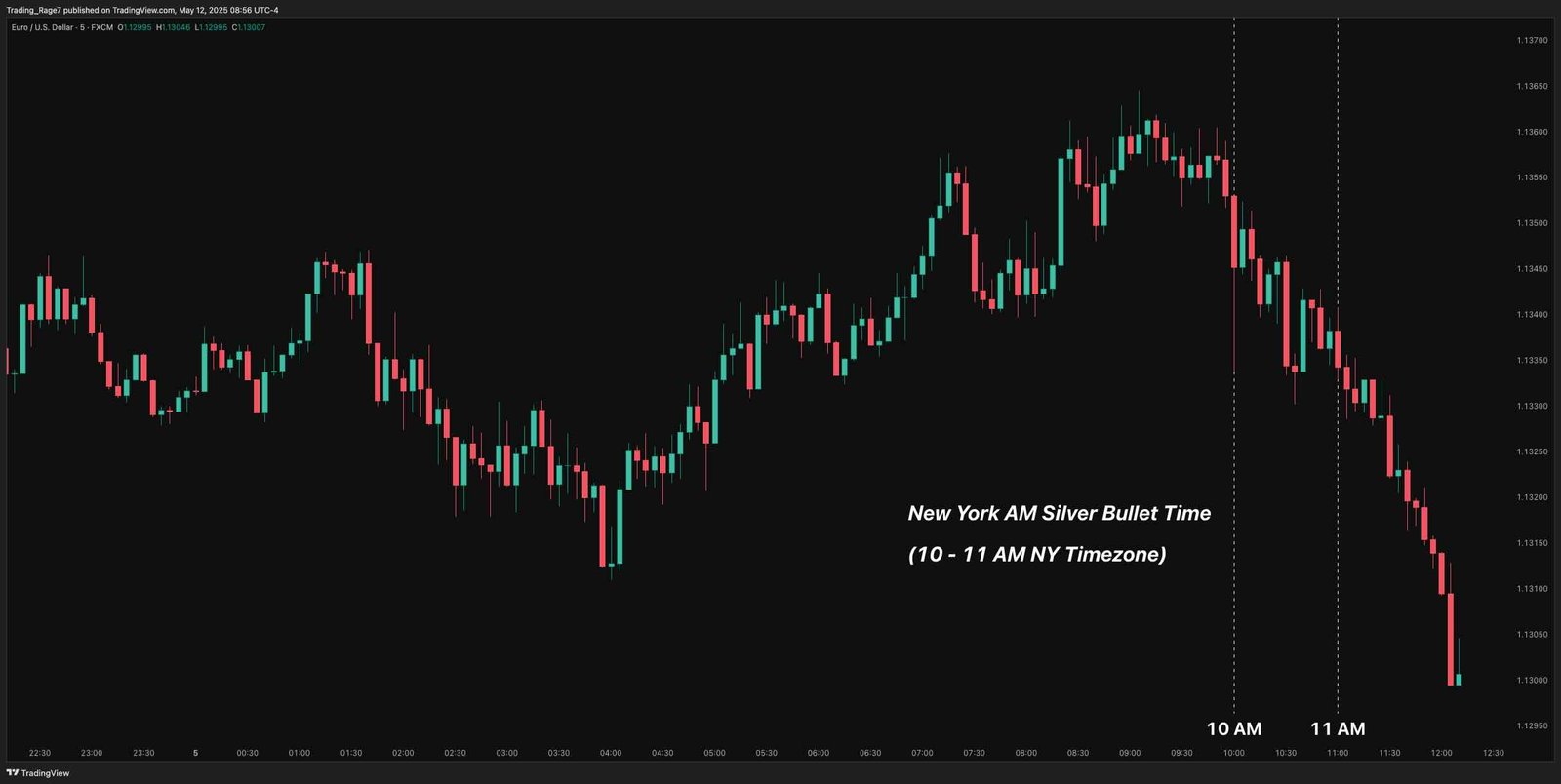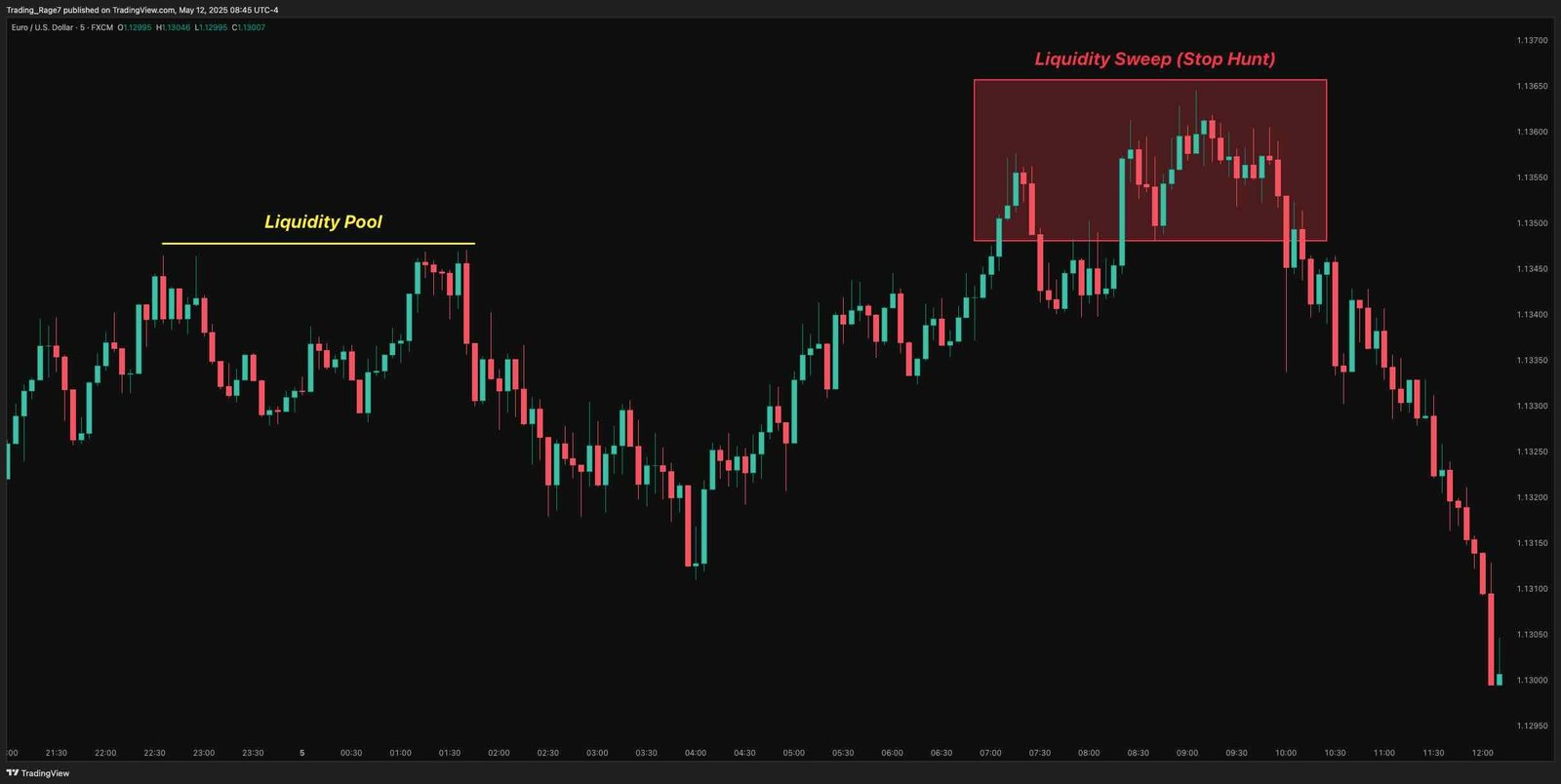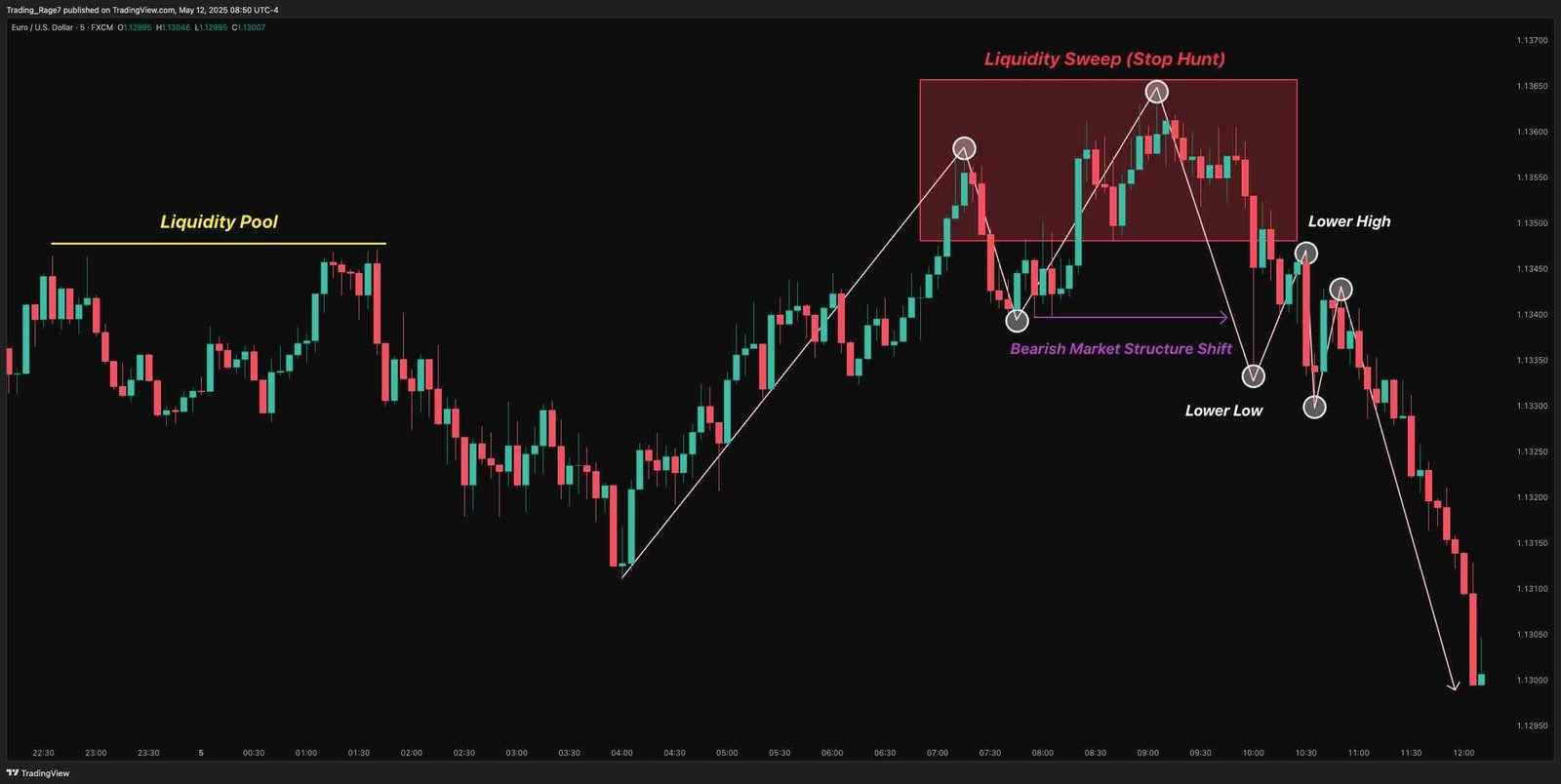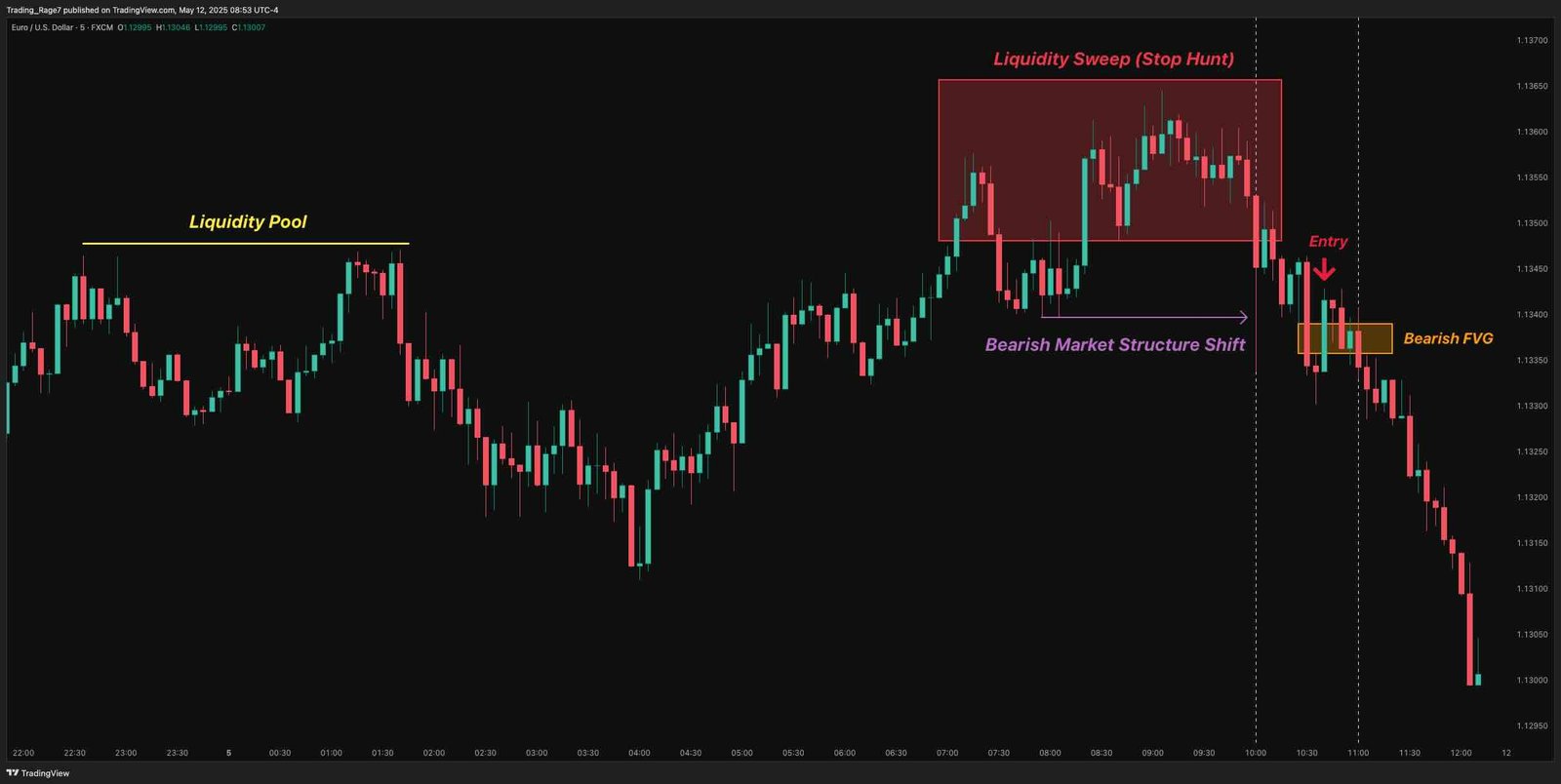The ICT Silver Bullet is one of the most talked-about trading strategies right now. It’s simple, time-based, and works best during specific hours of the day. The strategy looks for clean entries after a liquidity sweep, using fair value gaps for precise trade setups.
It’s popular because it gives clear rules, takes little screen time, and often catches high-probability moves. If you’re tired of staring at charts all day, this strategy might be what you need. In this post, we’ll break down what the ICT Silver Bullet is and how it works with clear practical examples.
- The ICT Silver Bullet is a time-based strategy that focuses on finding one clean trade during specific trading windows.
- It relies on three core elements: a liquidity sweep, a market structure shift (MSS), and a return to a fair value gap (FVG) for precise entries.
- The key time windows for Silver Bullet setups are: London (3–4 AM EST), New York AM (10–11 AM EST), and New York PM (2–3 PM EST).
- Risk management is essential—stick to small position sizes, use clear stop-losses, and aim for at least a 1:1 reward-to-risk ratio.
- This strategy works for both CFD and binary options traders, as long as the timing and setup rules are followed strictly.
- Success with Silver Bullet requires patience, discipline, and consistent practice through demo trading or backtesting.
What Is the ICT Silver Bullet Strategy?
The ICT Silver Bullet is a time-based trading setup created by Michael J. Huddleston, also known as Inner Circle Trader (ICT). It focuses on finding one clean trade during specific times of the day, usually right after a liquidity grab.
The idea is simple: the market often makes a fake move during certain hours to take out stops (that’s the liquidity sweep). Right after that, price usually shifts direction and creates a small imbalance or gap, which is called a Fair Value Gap (FVG). That’s where the Silver Bullet comes in. You wait for the price to come back to that gap and take your entry there.
The setup is meant to be fast and super simple. It removes the need to sit at the charts all day. Just show up at the right time, look for the right signs, and take the trade if it lines up. It’s called a “Silver Bullet” because it’s meant to be your one clean, focused shot. No overtrading and no second-guessing.
How to Trade the ICT Silver Bullet Strategy
The ICT Silver Bullet setup is built around four main concepts: time, liquidity, market structure, and fair value gaps (imbalances). Let’s break them down and provide a step-by-step guide to the Silver Bullet strategy:
1. Specify the ICT Silver Bullet Times
The Silver Bullet setup works because it focuses on a specific time period. You can’t just trade anytime you like. You should wait for the right moment, then look for the right structure. This strategy only works during three specific windows when big moves usually happen. Here are the ICT Silver Bullet times in different time zones:
| Session | EST | GMT | UTC |
|---|---|---|---|
| London Session | 3:00 AM – 4:00 AM | 8:00 AM – 9:00 AM | 8:00 AM – 9:00 AM |
| New York AM Session | 10:00 AM – 11:00 AM | 3:00 PM – 4:00 PM | 2:00 PM – 3:00 PM |
| New York PM Session | 2:00 PM – 3:00 PM | 7:00 PM – 8:00 PM | 6:00 PM – 7:00 PM |
These are times when the market is active, and liquidity grabs are more likely. If you trade outside these windows, it’s not really a Silver Bullet setup. Timing is everything.

The image above shows a clearly specified time period, which is the New York AM ICT Silver Bullet time, from 10 to 11 AM Eastern time.
2. Wait for Liquidity Sweep
Liquidity is where the money sits in the market. Think of all the stop losses sitting above highs or below lows. That’s what big players target, and the reason is that this liquidity will be the counterparty to their buy or sell orders to get in/out of the market without moving the price too much. Look for a clear liquidity pool formed before the ICT Silver Bullet hours, and wait for it to get swept.

As the chart above suggests, The Silver Bullet starts after a move that grabs this liquidity. You don’t want to enter before that sweep happens, because you might be caught in the sweep.
3. Look for a Market Structure Shift (MSS)
Once liquidity is taken, the market usually changes direction. You’ll often see a sharp move that breaks the recent trend. That’s your market structure shift. It tells you the trend has changed, and it’s time to get ready to enter.

Looking at the chart above, a clear market structure shift happened when the price created a lower low and a lower high compared to the previous primary pivots. From this point on, we’re looking for shorts as the trend has shifted bearish.
4. Identify and Execute on a Fair Value Gap (FVG)
After the shift, the price often leaves behind a small imbalance. That’s your fair value gap. ICT traders use it as the ideal entry zone. The idea is to wait for the price to return to that gap and then enter in the direction of the shift.

When all three line up, like the chart above (a liquidity sweep, a clear shift, and a clean FVG), that’s your Silver Bullet. You can execute your trade when the price comes back inside the fair value gap.
You can then ride the trend to reach your target, or close the trade when it reaches a certain risk-reward ratio. Moreover, you can also use this strategy for binary options trading, but make sure to set the expiry 3-5 times your entry timeframe.
Risk Management and Trade Optimization
Even with a solid setup like the Silver Bullet, risk management is key. Trust me, I’ve learned it the hard way. One bad trade shouldn’t wipe out your wins. So, here are some suggestions and rules we need to follow:
- Don’t Risk Too Much: I personally stick to 0.5% or 1% risk per trade, and I suggest you do so too. Especially when you’re still learning the setup. Don’t risk more just because it looks “perfect.”
- Always use a stop-loss: Your stop usually goes just beyond the liquidity level that got swept, or above/below a recent high/low. That way, if the price keeps going the wrong way, you’re out quickly.
- Know your target: Look for clean levels where the market is likely to react, like the opposite side of the range or a liquidity pool at recent high/low. Make sure your target gives you at least the amount you risk (1:1 risk-reward ratio or higher).
- Don’t force a trade: If the setup doesn’t appear during the time window, skip it. The ICT Silver Bullet is about one clean move. You’re not meant to trade all day. Don’t let overtrading ruin you.
- Track your performance: Keep a journal. Mark your entries, exits, wins, losses, and why you took each trade. Over time, this helps you refine your timing and strategy.
- Practice, Practice, and Practice: Use a backtesting tool or, even better, a demo account to practice before trading the ICT Silver Bullet with real funds. You can use the demo accounts CFD brokers provide, or even use free binary options demo accounts if you’re a binary trader.
Conclusion
The ICT Silver Bullet strategy is all about timing, structure, and precision. It’s not about taking random trades. You should wait for one solid setup during key hours of the day, which are the ICT Silver Bullet times.
If you follow the rules (watch for the sweep, confirm the shift, and enter on the gap), you’ll avoid overtrading and get cleaner results.
Like any strategy, it takes practice. But once you get the hang of it, the Silver Bullet can become your go-to strategy for reliable results over the long term.




